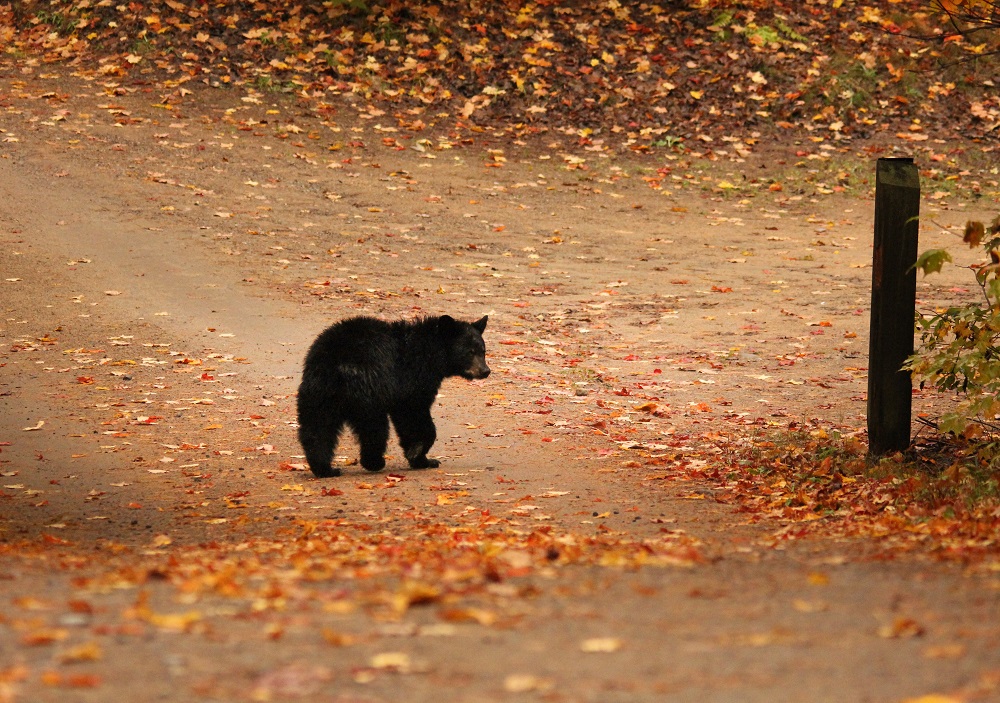The nights are getting cooler, the days are getting shorter, and the bears know there is limited time to finish packing on the pounds before retiring to their winter dens.
Food will only be available until about mid-October, so the days of feasting are quickly ending.
Like the summer, in September bears are focused on eating. But these days, that focus reaches a whole new level, called hyperphagia.
… hyperphagia?
Hyperphagia is an abnormally increased appetite. No matter how much you eat, your hunger does not decrease.

Black Bears enter a enter a state of hyperphagia in the late summer and fall.
Fall is when there is normally an abundance of food, and bears waste no time consuming all that is available.
They can spend 20 hours per day foraging!
Soft mast foods vs. hard mast foods
Soft mast foods are fruits and berries like cherries, raspberries, blackberries, and blueberries.
These become available in early summer and continue to be available until September.
Hard mast foods are nuts like acorns, beech nuts, and hazelnuts.

These take a bit longer to develop than soft mast, becoming available in late August into September.
Hard mast crops are higher in calories than summer food sources. There are roughly 260 calories in one pound of blueberries, but one pound of acorns has over 1,700 calories!
Bears are able to gain the most amount of weight from the hard mast food sources available in the fall.
However, not all bears have access to hard mast foods like acorns from Red Oak Trees or beech nuts from American Beech Trees.

Bears living in northern areas where these species don’t grow are more reliant on soft mast foods. Mountain Ash Berries are a very important fall food source for Black Bears in the boreal forests of northern Ontario.
How much weight can bears gain in the fall?
If hard mast food sources like acorns and beech nuts are abundant, Black Bears can gain up to 1 kg, or just over 2 pounds, per day.
By the time a bear is ready to enter its den, it may have doubled its body weight from when it woke up in the spring.
Bears are not concerned with their expanding waistline — in fact, it’s a sign of a healthy bear!
Going into their dens with a thick fat layer means bears will able to survive winter, reproduce, and care for young better than bears who go into the den in poor condition.
Make some noise on that fall colours hike!
One of the best times to visit parks is when the fall colours are in full swing. But hiking in the fall requires extra preparation and safety considerations.
During hyperphagia, bears are so extremely focused on food that they might not hear someone approaching.

Give the bears some warning. Talk, sing, shout “hey bear” every once in a while — anything to let wildlife know you are approaching.
Bears don’t want to run into you just as much as you don’t want to run into them.
If they can sense you beforehand, bears will often avoid you entirely.
Lock up your wildlife attractants!
Because bears are so focused on finding food, we do not want to tempt them into campsites or campgrounds by having items like food and toiletries available for them to investigate.

If you are backcountry camping, hang your food pack in a tree four metres off the ground and two metres away from the tree trunk.
If you’re car camping, keep all wildlife attractants in the closed trunk of your locked car. Please make sure all the windows are closed too!
Be Bear Wise!
Black Bears are amazing animals.
Let’s all do our best to respect and coexist with the Black Bears who call our protected areas home!
